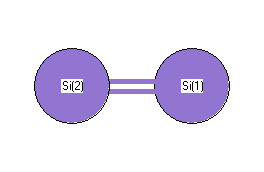Jump to
S2C1
Energy calculated at HF/6-31G
| | hartrees |
|---|
| Energy at 0K | -577.683926 |
| Energy at 298.15K | -577.682592 |
| Nuclear repulsion energy | 44.868134 |
The energy at 298.15K was derived from the energy at 0K
and an integrated heat capacity that used the calculated vibrational frequencies.
Geometric Data calculated at HF/6-31G
Point Group is D∞h
Cartesians (Å)
| Atom |
x (Å) |
y (Å) |
z (Å) |
|---|
| Si1 |
0.000 |
0.000 |
1.156 |
| Si2 |
0.000 |
0.000 |
-1.156 |
Atom - Atom Distances (Å)
| |
Si1 |
Si2 |
| Si1 | | 2.3116 |
Si2 | 2.3116 | |
 More geometry information
More geometry information
Electronic energy levels
Charges, Dipole, Quadrupole and Polarizability
Charges from optimized geometry at HF/6-31G
Charges (e)
| Number |
Element |
Mulliken |
CHELPG |
AIM |
ESP |
| 1 |
Si |
0.000 |
|
|
|
| 2 |
Si |
0.000 |
|
|
|
Electric dipole moments
Electric dipole components in Debye
(What's a Debye? See section
VII.A.3)
| |
x |
y |
z |
Total |
| |
0.000 |
0.000 |
0.000 |
0.000 |
| CHELPG |
|
|
|
|
| AIM |
|
|
|
|
| ESP |
|
|
|
|
Electric Quadrupole moment
Quadrupole components in D Å
| Primitive |
|---|
| | x | y | z |
|---|
| x |
-26.852 |
0.000 |
0.000 |
| y |
0.000 |
-26.852 |
0.000 |
| z |
0.000 |
0.000 |
-37.391 |
|
| Traceless |
|---|
| | x | y | z |
|---|
| x |
5.270 |
0.000 |
0.000 |
| y |
0.000 |
5.270 |
0.000 |
| z |
0.000 |
0.000 |
-10.539 |
|
| Polar |
|---|
| 3z2-r2 | -21.078 |
|---|
| x2-y2 | 0.000 |
|---|
| xy | 0.000 |
|---|
| xz | 0.000 |
|---|
| yz | 0.000 |
|---|
|
Polarizabilities
Components of the polarizability tensor.
Units are
Å
3 (Angstrom cubed)
Change units.
| |
x |
y |
z |
| x |
17.095 |
0.000 |
0.000 |
| y |
0.000 |
17.095 |
0.000 |
| z |
0.000 |
0.000 |
20.176 |
<r2> (average value of r
2) Å
2
| <r2> |
52.342 |
| (<r2>)1/2 |
7.235 |
Jump to
S1C1
Energy calculated at HF/6-31G
| | hartrees |
|---|
| Energy at 0K | -577.606720 |
| Energy at 298.15K | -577.605422 |
| Nuclear repulsion energy | 48.568376 |
The energy at 298.15K was derived from the energy at 0K
and an integrated heat capacity that used the calculated vibrational frequencies.
Geometric Data calculated at HF/6-31G
Point Group is D∞h
Cartesians (Å)
| Atom |
x (Å) |
y (Å) |
z (Å) |
|---|
| Si1 |
0.000 |
0.000 |
1.068 |
| Si2 |
0.000 |
0.000 |
-1.068 |
Atom - Atom Distances (Å)
| |
Si1 |
Si2 |
| Si1 | | 2.1355 |
Si2 | 2.1355 | |
 More geometry information
More geometry information
Electronic energy levels
Charges, Dipole, Quadrupole and Polarizability
Charges from optimized geometry at HF/6-31G
Charges (e)
| Number |
Element |
Mulliken |
CHELPG |
AIM |
ESP |
| 1 |
Si |
0.000 |
|
|
|
| 2 |
Si |
0.000 |
|
|
|
Electric dipole moments
Electric dipole components in Debye
(What's a Debye? See section
VII.A.3)
| |
x |
y |
z |
Total |
| |
0.000 |
0.000 |
0.000 |
0.000 |
| CHELPG |
|
|
|
|
| AIM |
|
|
|
|
| ESP |
|
|
|
|
Electric Quadrupole moment
Quadrupole components in D Å
| Primitive |
|---|
| | x | y | z |
|---|
| x |
-31.282 |
0.000 |
0.000 |
| y |
0.000 |
-31.282 |
0.000 |
| z |
0.000 |
0.000 |
-19.066 |
|
| Traceless |
|---|
| | x | y | z |
|---|
| x |
-6.108 |
0.000 |
0.000 |
| y |
0.000 |
-6.108 |
0.000 |
| z |
0.000 |
0.000 |
12.216 |
|
| Polar |
|---|
| 3z2-r2 | 24.433 |
|---|
| x2-y2 | 0.000 |
|---|
| xy | 0.000 |
|---|
| xz | 0.000 |
|---|
| yz | 0.000 |
|---|
|
Polarizabilities
Components of the polarizability tensor.
Units are
Å
3 (Angstrom cubed)
Change units.
| |
x |
y |
z |
| x |
-2.646 |
0.000 |
0.000 |
| y |
0.000 |
-2.646 |
0.000 |
| z |
0.000 |
0.000 |
15.549 |
<r2> (average value of r
2) Å
2
| <r2> |
48.918 |
| (<r2>)1/2 |
6.994 |
